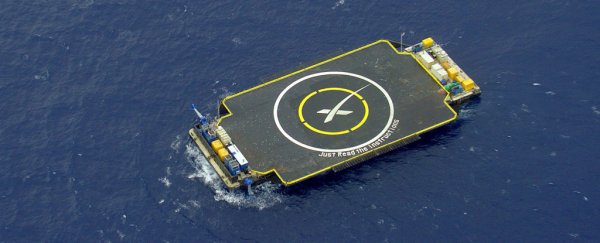Just one month after making history with its successful touchdown of an orbit-capable first stage booster rocket on land, SpaceX is reaching for another record. The private space company has announced that it will attempt the same feat at sea, this time landing a Falcon 9 rocket on a remotely controlled drone ship.
Scheduled to take off on January 17, SpaceX will launch another of its Falcon 9 rockets from the Vandenberg Air Force Base in California. The purpose of the mission is to carry NASA's Jason–3 ocean-monitoring satellite into space, but the more dramatic import of the launch will commence before the cargo has even been delivered, with SpaceX attempting the world's first successful landing of a first stage rocket on a floating sea platform.
Approximately 2 minutes after the Falcon 9 has taken off, the first stage booster will separate from the rest of the rocket and flip around, according to a report by Irene Klotz at Reuters. Firing engines to slow its fall, the first stage will deploy landing legs and be directed to make a vertical landing on a floating drone barge in the Pacific Ocean.
In conventional rocket flight, the first stage – which carries a huge amount of fuel – is discarded after takeoff, but the practice is a costly one. Elon Musk, the founder and CEO of SpaceX (in addition to Tesla), has valued the component in SpaceX's Falcon 9 rockets as being worth around US$61 million, whereas the fuel it contains amounts to approximately US$200,000.
SpaceX has effectively been founded on the promise of developing technologies that enable us to reuse rocket parts like the first stage, and in doing so, will drastically cut down on the huge costs involved with space flight launches, perhaps by as much as 100 times.
The advantages of being able to land rockets on things like drone ships are numerous, making the operation even more economical. As Devin Coldewey at NBC News explains:
"Having a mobile landing platform means more flexibility in when and how launches can proceed – it's not always convenient or possible for a rocket to return to a static site like a launch facility or other suitably flat, empty space. A mobile landing site could conceivably be placed where it is safest or most fuel-efficient for the rocket to come down."
This isn't the first time SpaceX has tried to bring one of its rockets down safely at sea. The company has unsuccessfully attempted ocean landings before, but after last month's success, hopes are high it can pull this one off.
Interestingly, the rocket being used in this upcoming launch is an older version of the Falcon 9 that was used last month and does not have sufficient power to touch down on land, SpaceX has said.
Despite investing so heavily in reusable rocket technologies, the company intends to retire last-month's history-making Falcon 9 from service.
"I think we'll probably keep this one on the ground because it's quite unique, it's the first one we brought back," Musk said in a conference call after the successful landing, Coldewey reports. "[J]ust confirm through tests that it could fly again, and then put it somewhere to display."
SpaceX will likely be live-streaming the event this Sunday, so watch this space for details on how to tune in.
